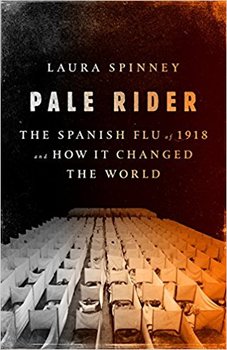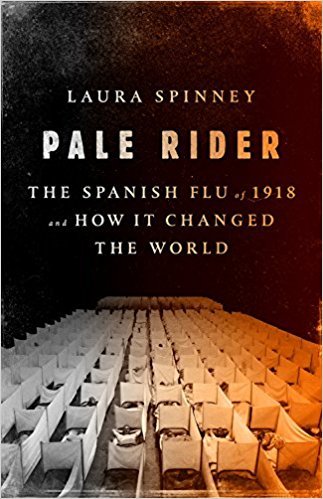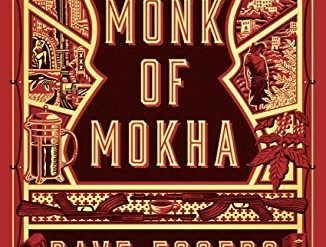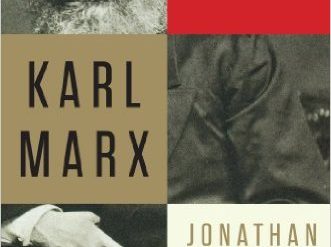
A future pandemic of devastating proportions is all too possible given our limited understanding of how to predict the emergence of new strains of killer flu. History could well prove that the COVID-19 pandemic gave us only a foretaste of what is to come. But there is worse in our history. Much worse.
If you’re unfamiliar with the history of the Spanish Flu of 1918, or if your understanding of the pandemic is rooted in what you read many years ago, you may be unfamiliar with its tragic dimensions. British science journalist Laura Spinney sets us all straight in Pale Rider: The Spanish Flu of 1918 and How It Changed the World.
“The Spanish flu infected one in three people on earth,” she writes, “or 500 million human beings. Between the first case recorded on 4 March 1918, and the last sometime in March 1920, it killed 50-100 million people, or between 2.5 and 5 per cent of the global population.”
Erupting in three waves, the killer flu brought about social, political, and economic changes reminiscent of those of the Black Death nearly 600 years earlier. And its impact was global, whereas the Black Death brought disaster largely to Europe and Asia.
Pale Rider: The Spanish Flu of 1918 and How It Changed the World by Laura Spinney (2017) 352 pages ★★★★☆
“The biggest disaster of the 20th Century”
The Spanish Flu was, Spinney asserts, “the biggest disaster of the twentieth century.” In all likelihood, the disease killed more than World Wars I and II combined. We Westerners may fail to recognize the pandemic’s catastrophic scope because Europe and North America “reported the lowest death rates, on average, so their experiences were atypical.” But as we know, that was not the case in a future pandemic.
In India, for example, including present-day Pakistan and Bangladesh, “the rate was ten times that in America.” Spinney reports that “an estimated 500,000 children were orphaned in South Africa alone,” and as many as 18 million Indians died in the pandemic, about 6 per cent of its population. However, the author’s emphasis is less on the sheer numbers of casualties than it is on the multiple effects on society at large. For instance, she believes that the flu helped push India closer toward independence (and of course explains her reasoning in detail). Her exploration of the long-term consequences is sobering.
A century ago, science-based medicine was in its infancy
It may be difficult for us today to grasp just how different the world was merely a century ago when the Spanish Flu broke out. Spinney reminds us that “life expectancy at birth in Europe and America did not exceed fifty, and in large parts of the globe it was much lower. Indians and Persians, for example, were lucky to celebrate their thirtieth birthdays.” Science-based medicine was in its infancy even in the wealthiest countries. What today we call “alternative” therapies such as osteopathy or homeopathy were at least as likely to gain the trust of those who fell ill. In fact, physicians may have done as much harm as good, the Hippocratic Oath notwithstanding. Little wonder.
“Viruses occupied only a tiny corner of the psychic universe of 1918. They hadn’t been seen, and there was no test for them”—much less a vaccine or any effective treatment. To compound matters, other epidemic diseases were often raging simultaneously, including typhus and bubonic plague. In many areas, doctors were convinced the flu was the plague.
The “Spanish” flu may have been American . . . or Chinese
Spinney explains that the label “Spanish” flu is a misnomer. She traces the wide-ranging research into the true origins of the disease, identifying the leading candidates as the United States, China, and the Western Front in the European War. Her account wanders all over the globe, zeroing in on such far-flung communities as Odessa, Russia; Kimberley, South Africa; Rio de Janeiro, Brazil; Zamora, Spain; and Bristol Bay, Alaska. These accounts are deeply disturbing. As is the case in so many circumstances, the poor were the hardest hit everywhere. Spinney notes that “it was bad diet, crowded living conditions and poor access to healthcare that weakened the constitution, rendering the poor, immigrants and ethnic minorities more susceptible to disease.” And those suffering from existing diseases were at the greatest risk.
No guarantee that another future pandemic won’t happen next year
Although Pale Rider is predominantly a work of history, and social history in particular, Spinney does delve into the scientific aspects of the pandemic. She explains the historical origins of influenza, the centuries-long efforts to understand it, and the development of vaccines beginning in the 1930s—too late, of course, to help those who fell to the Spanish Flu.
However, as you’re no doubt aware, the ability of scientists to produce flu vaccines on an annual basis is no guarantee that another pandemic of similar scope won’t happen next year. There are simply too many varieties of influenza, and at least two strains of influenza type A—H1N1, which was the basis of the Spanish Flu, and H5N1—have the potential to break out at any time in the future. And H5N1 kills some 60 per cent of the people it infects. We can only hope that an effective vaccine can be designed and manufactured in time and that today’s greater understanding of public health requirements will keep the death rate in check.
My only complaint about Pale Rider is that the book is structured in a way that requires some degree of repetition. Since it’s not arranged in chronological order or divided into neat categories, the book can be confusing. Spinney writes in circles. I got dizzy. But the problem is minor in the context of such an informative and well-written account.
For related reading
I’ve reviewed three other books about epidemiology:
- Pandemic: Tracking Contagions from Cholera to Ebola and Beyond by Sonia Shah (The existential threat of contagious disease)
- Spillover: Animal Infections and the Next Human Pandemic by David Quammen (Where do all those emerging diseases come from?)
- The Great Influenza: The Story of the Deadliest Pandemic in History by John M. Barry (A brilliant account of the 1918 flu epidemic)
And you can find a list of books on related topics at Books about epidemic disease and the COVID-19 pandemic.
In Science science explained in 10 excellent popular books, I include two excellent books on epidemiology that may be of interest to you.
This is one of the books I’ve included in my post, Gaining a global perspective on the world around us.
For interesting speculation about the possible impact of a future pandemic, you might turn to science fiction as well. In my newest book, Hell on Earth: What we can learn from dystopian fiction, I review and comment on a number of novels that portray Earth after a pandemic.
You may enjoy browsing through 20 top nonfiction books about history.
And you can always find my most popular reviews, and the most recent ones, on the Home Page.


























